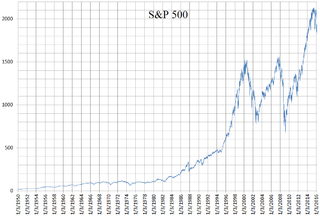Related Research Articles

The Dow Jones Industrial Average (DJIA), Dow Jones, or simply the Dow, is a stock market index of 30 prominent companies listed on stock exchanges in the United States.

A stock market, equity market, or share market is the aggregation of buyers and sellers of stocks, which represent ownership claims on businesses; these may include securities listed on a public stock exchange, as well as stock that is only traded privately, such as shares of private companies which are sold to investors through equity crowdfunding platforms. Investment is usually made with an investment strategy in mind.
Investment is traditionally defined as the "commitment of resources to achieve later benefits". If an investment involves money, then it can be defined as a "commitment of money to receive more money later". From a broader viewpoint, an investment can be defined as "to tailor the pattern of expenditure and receipt of resources to optimise the desirable patterns of these flows". When expenditure and receipts are defined in terms of money, then the net monetary receipt in a time period is termed as cash flow, while money received in a series of several time periods is termed as cash flow stream. Investment science is the application of scientific tools for investments.
In 2001, stock prices took a sharp downturn in stock markets across the United States, Canada, Asia, and Europe. After recovering from lows reached following the September 11 attacks, indices slid steadily starting in March 2002, with dramatic declines in July and September leading to lows last reached in 1997 and 1998. The U.S. dollar increased in value relative to the euro, reaching a 1-to-1 valuation not seen since the euro's introduction.

The Wall Street Crash of 1929, also known as the Great Crash, the Crash of 29 was a major American stock market crash that occurred in the autumn of 1929. It started in September and ended in mid-November, when share prices on the New York Stock Exchange (NYSE) collapsed. The pivotal role of the 1920s' high-flying bull market and the subsequent catastrophic collapse of the NYSE in late 1929 is often highlighted in explanations of the causes of the worldwide Great Depression.

The Standard and Poor's 500, or simply the S&P 500, is a stock market index tracking the stock performance of 500 of the largest companies listed on stock exchanges in the United States. It is one of the most commonly followed equity indices. As of December 31, 2021, according to surveys, more than $7.1 trillion was invested in assets tied to the performance of the index.

Charles Henry Dow was an American journalist who co-founded Dow Jones & Company with Edward Jones and Charles Bergstresser.
The dividend yield or dividend–price ratio of a share is the dividend per share, divided by the price per share. It is also a company's total annual dividend payments divided by its market capitalization, assuming the number of shares is constant. It is often expressed as a percentage.
A stock fund, or equity fund, is a fund that invests in stocks, also called equity securities. Stock funds can be contrasted with bond funds and money funds. Fund assets are typically mainly in stock, with some amount of cash, which is generally quite small, as opposed to bonds, notes, or other securities. This may be a mutual fund or exchange-traded fund. The objective of an equity fund is long-term growth through capital gains, although historically dividends have also been an important source of total return. Specific equity funds may focus on a certain sector of the market or may be geared toward a certain level of risk.
The Dogs of the Dow is an investment strategy popularized by Michael B. O'Higgins in a 1991 book and his Dogs of the Dow website.

The Dow Jones Global Titans 50 Index is a float-adjusted index of 50 of the largest and best known blue chip companies traded on the New York Stock Exchange, American Stock Exchange, Nasdaq, Euronext, London Stock Exchange, and Tokyo Stock Exchange. The index represents the biggest and most liquid stocks traded in individual countries. It was created by Dow Jones Indexes to reflect the globalization of international blue chip securities in the wake of mergers and the creation of megacorporations.
A high-yield stock is a stock whose dividend yield is higher than the yield of any benchmark average such as the ten-year US Treasury note. The classification of a high-yield stock is relative to the criteria of any given analyst. Some analysts may consider a 2% dividend yield to be high, whilst others may consider 2% to be low. There is no set standard for judging whether a dividend yield is high or low. Many analysts do however use indicators such as the previously mentioned comparison between the stock's dividend yield and the 10-Year US Treasury Note.

S&P Dow Jones Indices LLC is a joint venture between S&P Global, the CME Group, and News Corp that was announced in 2011 and later launched in 2012. It produces, maintains, licenses, and markets stock market indices as benchmarks and as the basis of investable products, such as exchange-traded funds (ETFs), mutual funds, and structured products. The company currently has employees in 15 cities worldwide, including New York, London, Frankfurt, Singapore, Hong Kong, Sydney, Beijing, and Dubai.
The S&P MidCap 400 Index, more commonly known as the S&P 400, is a stock market index from S&P Dow Jones Indices. The index serves as a gauge for the U.S. mid-cap equities sector and is the most widely followed mid-cap index. It is part of the S&P 1500, which also includes the S&P 500 for larger U.S. based companies, and the S&P 600 for smaller companies though all three indices include a handful of foreign stocks that trade on the U.S. stock exchanges.
The S&P SmallCap 600 Index is a stock market index established by Standard & Poor's. It covers roughly the small-cap range of American stocks, using a capitalization-weighted index.
The NYSE Arca Major Market Index, previously the AMEX Major Market Index, is the American price-weighted stock market index made up of 20 Blue Chip industrial stocks of major U.S. corporations. Several of the stocks are also components of the Dow Jones Industrial Average (DJIA).

In finance, a stock index, or stock market index, is an index that measures the performance of a stock market, or of a subset of a stock market. It helps investors compare current stock price levels with past prices to calculate market performance.
The Barron's 400 Index or B400 is a stock market index of 400 public companies in the United States, as selected by editors and associates of Barron's magazine. Established in 2007, the Barron's 400 has tended to outperform certain other major indexes at least through the first half of 2013.
References
- ↑ "NYSE Group, Inc". Nyse.com. Archived from the original on 2012-10-17. Retrieved 2011-09-19.
- ↑ Blue Chip Definition Investopedia
- ↑ Merriam-Webster, Merriam-Webster's Unabridged Dictionary, Merriam-Webster.
- ↑ Merriam-Webster, Merriam-Webster's Collegiate Dictionary, Merriam-Webster.
- ↑ Prestbo, John (12 March 2008). "Ever Wonder How 'Blue-Chip' Stocks Started?" (PDF). Dow Jones (internal news item). Retrieved 22 June 2018.
- ↑ "Dow Jones Industrial Average: Stock Index Summary". Bloomberg. 1928-10-01. Retrieved 2011-09-19.
- ↑ Sridhar, Sagar (2019-03-10). "Top 30 Canadian Blue Chip Stocks You Should Own (2023)". Personal Finance Freedom. Retrieved 2023-09-06.
- ↑ Sridhar, Sagar (2019-03-10). "Top 30 Canadian Blue Chip Stocks You Should Own (2023)". Personal Finance Freedom. Retrieved 2023-09-06.